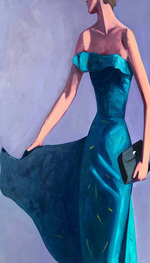Oklahoma subtext
#25Oklahoma subtext
Posted: 8/31/20 at 12:46am
Wow, you just described every single episode of Yellowstone!
What did some people see that others did not?"
People see what they want to see, it doesn't mean it was actually there. And since no one can actually give you a real answer, I think your question is now answered.
#26Oklahoma subtext
Posted: 8/31/20 at 12:07pm
Frumious Bandersnatch said: "Homoeroticism in a scene does not necessarily imply sexual attraction between the characters. The scene was plainly homoerotic."
^ This. I don't understand this passionate denouncement that audiences would find homoerotic subtext in a production so sensually charged. Both The Hollywood Reporter and Vox (along with some BroadwayWorld thread users) noticed that audiences found subtext, and finding that subtext doesn't diminish the show at all. Weird that Sutton finds it so "reaching" and "desperate" when all of her posts are fighting against what some audiences have read implicitly...
jimmycurry01
Broadway Legend Joined: 5/28/05
#27Oklahoma subtext
Posted: 8/31/20 at 12:43pm
A Director said: "Wayman_Wong said: "Here's a link (below) to an article by Daniel Pollack-Pelzner at Oregon Artswatch.''The Hidden History of 'Oklahoma!'; Contemporary Reinterpretations of the Classic American Musical May Be Getting Back to Its Root: It's Based on a Play by a Gay Cherokee Man.''
It explores the background of Lynn Riggs, the gay Native American who wrote ''Green Grow the Lilacs,'' the basis of ''Oklahoma!'' For instance:
Stephen Sondheim, whom [Oscar] Hammerstein took under his wing in the summer when he was writingOklahoma!, said in a recent interview that his mentor “took a play that was about homosexuality in the West and turned it into a sunny musical…beyond what Lynn Riggshad written, about the opening of territories, the promise of America.”
(“The play had distinct homoerotic undertones in the relationship between Curly and Jeeter,” Sondheim clarified in an email; Hammerstein changed Jeeter’s name to Jud in the musical.)
https://www.orartswatch.org/the-hidden-history-of-oklahoma/
I respect Sondheim, but his comments about Green Grow The Lilacs arenonsense. The play is not about homosexuality in the West. Hammerstein changed Jeeter's name to Jud so audiences wouldn't be reminded of Jeeter Lester in Tobacco Road.
Are the homoerotic undertones in the play? Perhaps. Today, Native American Theatre scholars make a strong case that characters in the play are Cherokee.
In the play, the scene after the wedding is dark and unsettling. In a stage direction, Riggs mentions Laurey comes out of the house in her nightgown and the men may have rapped her. After Jeeter is killed, Curley is taken off to jail. In the final scene, Curley has escaped from jail and returns to the farmhouse. The sheriff and his men arrived and demand Aunt Eller turn him over. She convinces them they should allow Curley to spend the night with Laurey and come back in at the morning to claim him. The sheriff agrees, but says some of the men will wait outside the house. Curley has exited into Laurey's room. We hear him singing Green Grow The Lilacs as the curtain falls.
"
Sondheim is not the only one to discuss a gay subtext in Riggs' play. There have been several other published essays that explore the topic. Native American writer Craig Womack stated that Riggs' writing "is better understood as the internal terrain as a closed gay man, than as an actual literal rendering of Oklahoma and its people." Now, I'm not saying that Green Grows the Lilacs is the 1930s version of Brokeback Mountain, but to categorically deny that a queer reading of the play is possible, or not worth being entertained, seems to be a bit benighted considering it was written by a gay man. It makes sense that some undercurrents of his own identity may lurk between the lines, and that is certainly worth noting and discussing.



